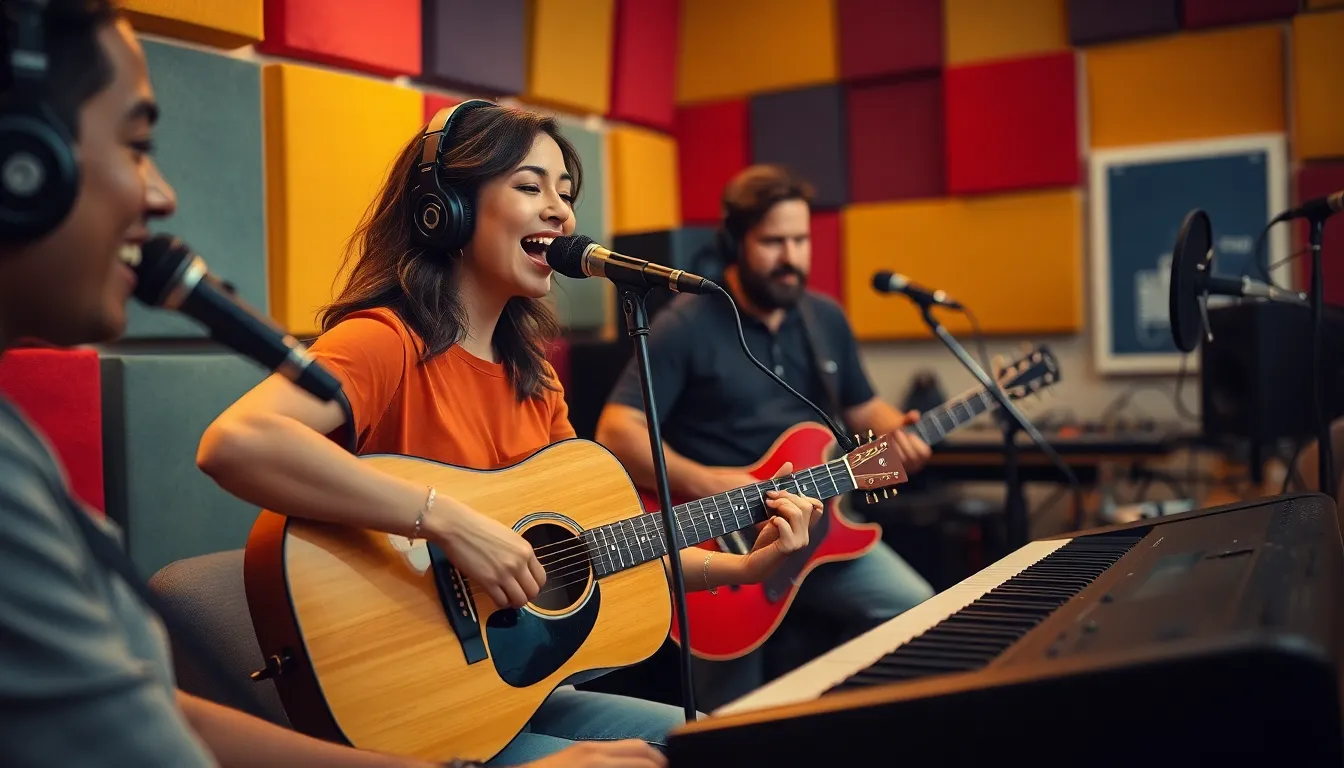Every hit song has a secret weapon: a solid structure. Think of it as the skeleton that holds the whole thing together. Without it, lyrics can feel like a jumbled mess, and melodies might just float away into the ether. Whether you’re a seasoned pro or a shower singer, understanding songwriting structure can transform your musical ideas into chart-topping tunes.
Songwriting Structure
A solid songwriting structure underpins memorable songs. Engaging melodies and lyrics thrive within well-defined frameworks.
Importance of Structure in Songs
Structure guides the flow of a song, providing clarity. Cohesive elements emerge when songwriters utilize established formats. A strong framework helps convey ideas effectively, enhancing listener impact. Songwriters often find that lacking structure leads to disjointed or confusing compositions. Well-organized songs typically resonate better with audiences, increasing emotional connections. Familiarity with structure equips musicians to experiment while maintaining coherence in their work.
Common Types of Song Structures
Numerous song structures exist to inspire creativity. The verse-chorus format stands out as one of the most popular. In this arrangement, verses set the scene, while the chorus encapsulates the song’s main theme. Another common structure includes the AABA format, consisting of two verses, a bridge, and a return to the verse. The verse-verse-bridge structure also appears frequently, allowing for dynamic variations. Each type offers unique opportunities for storytelling and emotional engagement. Understanding these structures enhances a songwriter’s toolkit, promoting versatility in creation.
Elements of Songwriting Structure

Understanding the key elements of songwriting structure facilitates the creation of impactful music. Each component plays a specific role in shaping the overall composition.
Verse
Verses establish the narrative and tone of the song. These sections provide context, introducing characters, settings, and emotions. Each verse typically evolves the story, adding deeper layers and introducing new details. Songwriters often vary melodies and lyrics in subsequent verses to maintain listener engagement. Skills in crafting compelling verses enhance storytelling, making the song relatable. Examples from popular music demonstrate how effective verses pull the audience into the song’s world.
Chorus
Choruses serve as the emotional core of a song. This section delivers the main message, often featuring catchy melodies and memorable lyrics. Repeating the chorus reinforces key themes, helping listeners connect emotionally. Ideal choruses contrast with verses in energy and rhythm, emphasizing the song’s main idea while creating anticipation. Many successful songs thrive on strong choruses that resonate with audiences, ensuring the song becomes memorable. These sections often inspire sing-alongs, making them essential in songwriting.
Bridge
Bridges introduce a shift in the song’s dynamics, providing contrast and revitalizing the composition. These sections offer new perspectives, enhancing emotional depth. While verses and choruses repeat familiar themes, bridges change up the melody or rhythm, creating a refreshing break. Skilled songwriters utilize bridges to explore different emotions, building tension before returning to the chorus. Many notable songs feature bridges that elevate the overall impact, pushing the narrative towards a climactic resolution. An effective bridge enriches the listening experience, making it a valuable tool in songwriting.
Popular Songwriting Structures
Songwriting structures provide frameworks that enhance song flow and emotional resonance. Familiarity with these structures encourages creativity and strengthens songwriting skills.
AABA Structure
The AABA structure contains two themes in an alternating pattern. It features an A section followed by another A, then a contrasting B section, and concludes with a return to the A section. This format allows songwriters to develop a narrative while introducing variation through the B section. Often, the B section provides a fresh emotional perspective that deepens the storytelling. Many classic songs, such as “Somewhere Over the Rainbow,” utilize this structure effectively.
Verse-Chorus Structure
The verse-chorus structure is among the most prevalent in popular music. In this format, verses progress the story or theme, while the chorus delivers a memorable and catchy hook. The chorus often contains the song’s central message, creating a powerful emotional impact. Variations in melody and lyrics throughout the verses maintain listener engagement. Numerous hit songs, including “Shape of You” by Ed Sheeran, demonstrate the effectiveness of this dynamic structure.
ABAB Structure
The ABAB structure offers a simple yet effective songwriting approach. Alternating between two distinct sections, A and B, creates a consistent flow. Each A section typically presents a related theme, while B sections add contrast or additional depth. This format promotes clarity and keeps the listener’s attention. Common in various genres, the ABAB structure appears in songs like “Hey Jude” by The Beatles, showcasing its versatility and broad appeal.
Tips for Writing with Structure
Effective songwriting relies on finding a unique voice that resonates with listeners. Each songwriter possesses distinct experiences, perspectives, and emotions. Embracing these attributes enhances authenticity in lyrics and melodies. Recognition of personal style strengthens connection with audiences, fostering lasting impact. Crafting songs that reflect individual experiences and emotions solidifies a songwriter’s place in the music landscape.
Additionally, experimenting with different forms expands songwriting capabilities. Discovering varied structures invites creativity and exploration, encouraging innovative ideas to flourish. Trying different formats—such as verse-chorus, AABA, or ABAB—can reveal fresh avenues for expression. Each structure presents opportunities for developing unique narratives and emotional depth. Fostering versatility in approach enriches musical catalog and keeps the songwriting process dynamic and engaging.
Conclusion
Understanding songwriting structure is vital for anyone looking to create memorable music. A solid framework not only enhances the flow of a song but also deepens emotional connections with listeners. By mastering various structures like verse-chorus or AABA, songwriters can effectively convey their ideas and stories.
Experimenting with different formats encourages creativity and allows for unique expressions. Each songwriter’s individual voice adds authenticity to their work, making it resonate even more. Embracing these principles can transform one’s songwriting journey, resulting in compositions that captivate and inspire.

